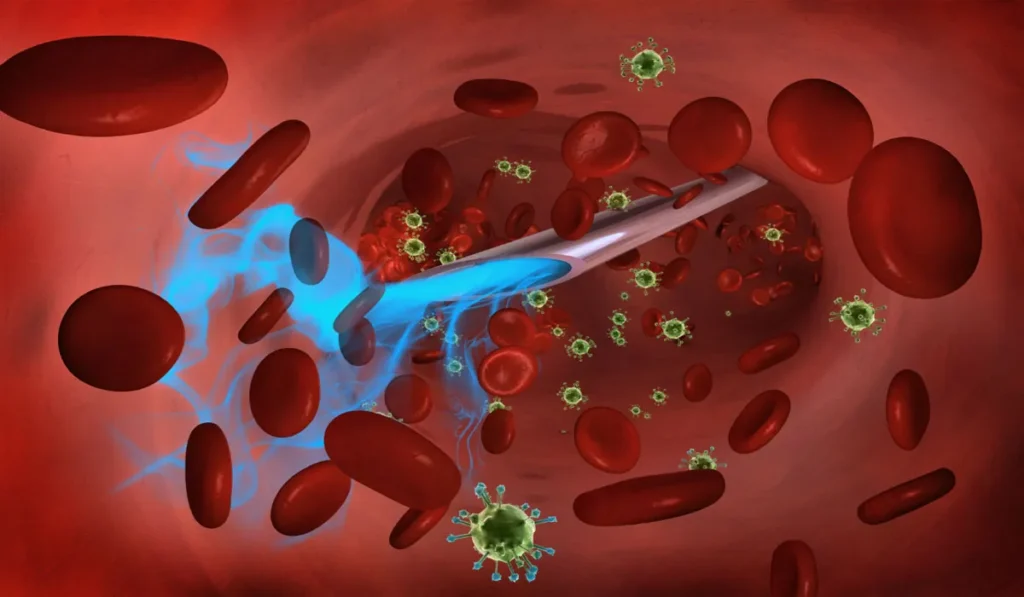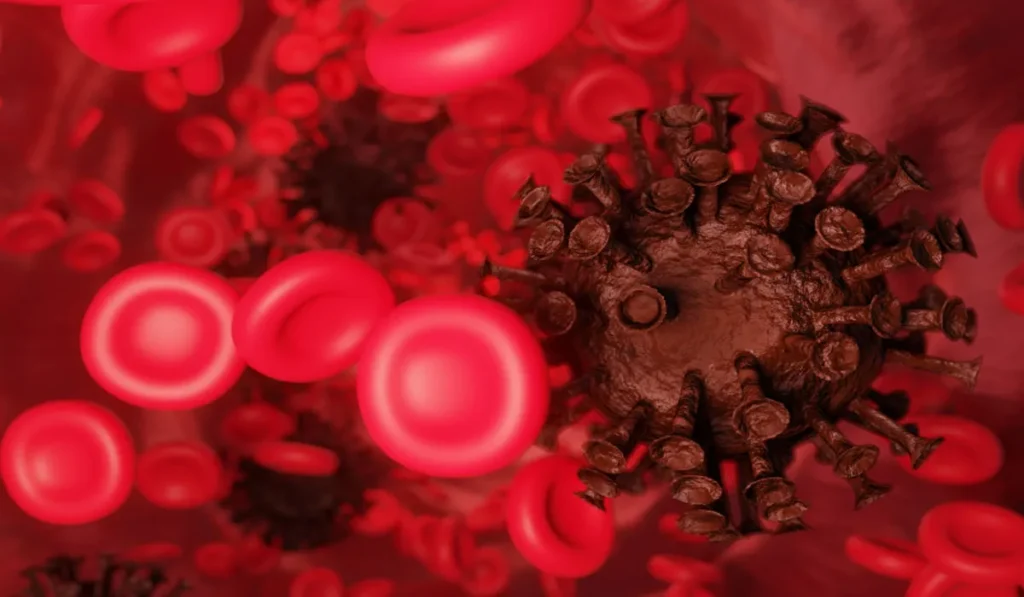Mold itself cannot enter the bloodstream. However, mold can produce toxins and allergens that may lead to health issues if inhaled or ingested, indirectly affecting the body’s systems. Direct bloodstream infection by mold is extremely rare and typically occurs only in individuals with compromised immune systems.
Understanding Mold and Its Effects on the Human Body

Definition of Mold and Mycotoxins
Mold is a type of fungus that grows in multicellular structures called hyphae. These tiny organisms thrive in moist environments and can be found both indoors and outdoors.
Molds reproduce by releasing spores, which are capable of surviving harsh conditions and can easily spread through the air.
A harmful byproduct of some molds is mycotoxins, toxic substances that can lead to health issues when humans and animals are exposed to them.
Brief on Common Types of Mold Found in the Environment
Several types of mold are commonly found in our surroundings. For instance, Aspergillus is often present in air conditioning systems and can contaminate food, while Stachybotrys, also known as black mold, is notorious for growing on water-damaged building materials.
Cladosporium and Penicillium are other molds that are typically found in damp areas and can contribute to indoor air pollution.
Explanation of How Mold Exposure Typically Occurs
Exposure to mold can happen through inhalation of mold spores, ingestion of moldy food, or skin contact with mold-contaminated surfaces.
Inhaling spores is the most common form of exposure, occurring when individuals breathe in air containing mold particles, often in poorly ventilated or water-damaged spaces.
Overview of Health Problems Caused by Mold Exposure
Mold exposure can lead to a variety of health problems, particularly for those with allergies or asthma.
Symptoms may include respiratory issues, coughing, sneezing, eye irritation, and skin rashes.
Chronic exposure to mold can also exacerbate lung conditions and, in some cases, lead to more serious health concerns such as mycotoxicosis, when mycotoxins enter the body and cause illness.
Possibility of Mold Entering the Bloodstream

Body’s Defense Mechanisms Against Inhaled or Ingested Mold
The human body has several defense mechanisms to protect against inhaled or ingested mold.
The immune system, mucous membranes, and cilia in the respiratory tract all work to capture and eliminate mold spores before they can cause harm.
The digestive system also helps prevent ingested mold from causing internal issues by breaking down and eliminating harmful substances.
Conditions Under Which Mold or Its Components Might Enter the Bloodstream
While mold itself does not typically enter the bloodstream, certain conditions can increase the risk.
Individuals with weakened immune systems, due to conditions like HIV/AIDS, cancer treatments, or organ transplants, are more susceptible to mold infections.
Mold or its mycotoxins can sometimes enter the bloodstream through the lungs or the digestive tract in these vulnerable individuals.
Immunosuppression and Its Effects on Mold Susceptibility
Immunosuppression greatly heightens an individual’s susceptibility to mold-related health problems.
When the immune system is compromised, the body’s natural defenses are weakened, making it more difficult to fight off mold spores and mycotoxins.
This can lead to invasive mold infections, which are more severe and can affect various organs, including the lungs, skin, and even the brain.
Invasive Mold Infections and At-Risk Populations
People with chronic lung diseases, those taking corticosteroids, and individuals undergoing immune-suppressing treatments are at higher risk for invasive mold infections.
These infections can be life-threatening and often require prompt and aggressive medical intervention.
Discussion of Rare Medical Cases Involving Mold in the Bloodstream
Rare medical cases have documented instances where mold has been found in the bloodstream.
Such cases are often associated with hospital-acquired infections where patients are exposed to mold through invasive devices or contaminated facilities.
These instances underscore the importance of strict infection control measures in healthcare settings.
Diagnosis, Treatment, and Prevention of Mold-related Health Issues

Methods of Diagnosing Mold Exposure and Related Illnesses
Diagnosing mold exposure involves a combination of patient history, physical examination, and sometimes testing for specific antibodies or mycotoxins in the blood.
Imaging tests like X-rays or CT scans can be used to look for signs of mold infection in the lungs.
Medical Treatments Available for Mold-related Conditions
Treatment for mold-related conditions can vary depending on the type and severity of the exposure. Antifungal medications are commonly used to treat invasive mold infections.
Allergic reactions may be managed with antihistamines or corticosteroids, and in the case of severe allergic responses, immunotherapy may be considered.
Strategies for Preventing Mold Exposure and Growth in Living Environments
Preventing mold exposure involves controlling moisture levels in living spaces. This includes fixing leaks, using dehumidifiers, and ensuring good ventilation.
Regular cleaning and maintenance of areas prone to mold growth, like bathrooms and kitchens, are also essential strategies.
Importance of Addressing Water Damage and Humidity Control to Prevent Mold Infestation
Addressing water damage promptly and effectively is crucial in preventing mold infestation.
Materials like drywall and carpeting that have been water-damaged should be removed and replaced.
Humidity control, by means of air conditioning and dehumidifiers, helps maintain an environment that is less conducive to mold growth.
FAQs About Can Mold Get in Your Bloodstream
Can mold spores directly enter your bloodstream?
Mold spores themselves cannot directly enter the bloodstream under normal circumstances.
What happens if you inhale mold spores?
Inhaling mold spores can lead to health issues such as allergic reactions or respiratory problems, but it does not result in mold entering the bloodstream.
Can mold produce toxins that affect your body?
Yes, mold can produce toxins and allergens that may indirectly affect the body’s systems if inhaled or ingested.
Is it possible for mold to cause bloodstream infections?
Direct bloodstream infection by mold is extremely rare and typically occurs only in individuals with compromised immune systems.
How can you prevent health issues related to mold?
Preventing health issues related to mold involves controlling moisture levels in your environment, cleaning visible mold promptly, and ensuring good ventilation.
Final Thoughts
Mold itself typically cannot invade the bloodstream. The primary health concerns arise from mold-produced toxins and allergens, which can cause reactions when inhaled or ingested.
True bloodstream infections by mold are exceedingly rare, mostly affecting those with significantly weakened immune systems.
